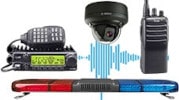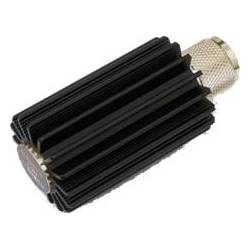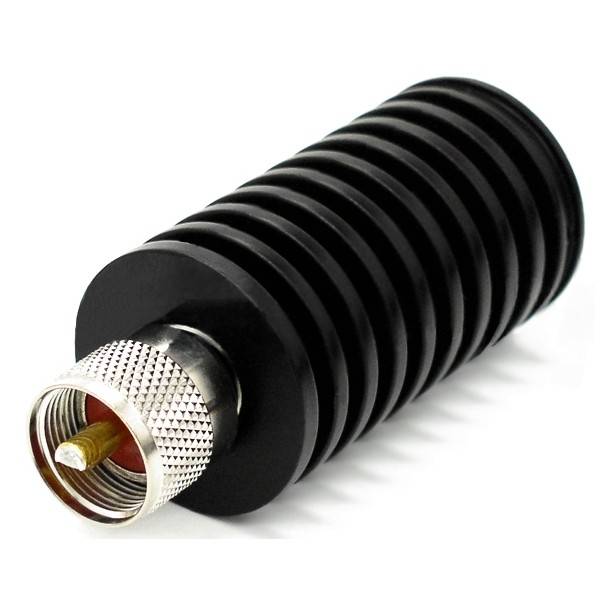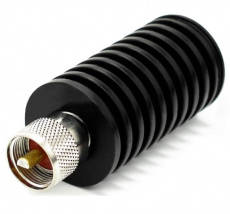Antenna Dummy Load
Antennas are an essential part of wireless communication systems. Whether it is a mobile phone, radio or satellite, these systems all rely on antennas to transmit and receive signals. In order for antennas to work effectively, they must be thoroughly tested before installation. That's where the antenna workload comes into play. Read more...
• Frequency: 0-500 Mhz
• Impedancia: 50 Ohm
• Maximum power rating: 20W (continuous) 60W (short time)
• VSWR: 1.0 < 50 Mhz : 1.15 >100 Mhz : 1.5 above 250 Mhz
• Connection: UHF-male
• Dimensions: 30 x 75 mm
• Frequency: 0-1000 Mhz
• Impedancia: 50 Ohm
• Maximum power rating: 15W (continuous) 100W (short time)
• VSWR less than: 1.15:1 (1000 Mhz)
• Connection: UHF-male
• Dimensions: 32 x 81 mm
• Frequency: 0-1000 Mhz
• Impedancia: 50 Ohm
• Maximum power rating: 15W (continuous) 100W (short time)
• VSWR less than: 1.15:1 (1 Ghz), 1.2:1 (1-1.3 Ghz), 1.3:1 (1.3-1.5 Ghz)
• Connection: N-male
• Dimensions: 32 x 81 mm
How does Antenna Dummy Load work?
An artificial load is a device used to simulate the presence of an antenna in a transmission line. It is essentially a resistor attached to the end of the transmission line to absorb radio frequency (RF) energy that would otherwise be radiated by the antenna. This allows the transmitter to be tested without radiating RF energy into the environment, which could interfere with the operation of other electronic devices. The antenna load, or dummy load as many people call it, is designed to match the impedance of the transmission line, which is typically 50 ohms in most RF systems.
The impedance of the dummy load is also typically 50 ohms to prevent the signal from backing into the transmission line, which can cause standing waves and signal loss. Of course, in addition to 50 ohm impedance dummy loads, there are also RF systems with impedances of 75 and 300 ohms.
The dummy load is also called a dummy antenna, antenna terminator, load resistor or termination load. It is usually made of resistive materials such as carbon or metal oxide and is designed to dissipate RF energy in the form of heat. The power that a dummy load can handle depends on its power value, expressed in watts. For example, a 50 ohm dummy load rated at 100 watts can dissipate up to 100 watts of RF energy.
When else can an aAntenna Dummy Load be used?
A dummy load is an important component in testing and calibrating transmitters. It can be tested and adjusted by connecting it to the transmitter output without radiating RF energy into the environment. This is particularly important when testing high power transmitters that may cause interference to other electronic devices. Besides technical applications, artificial loads have also found their way into amateur and hobby radio circles. Radio amateurs use dummy loads to test their transmitters and simulate antenna loads for tuning and testing purposes.
In summary, dummy loads are a vital element in the testing, calibration and verification of transmitters. It allows the transmitter to be tested without radiating RF energy into the environment, ensuring proper operation of the transmitter. Whether you're a professional RF engineer or a radio amateur, the artificial load is a tool you should keep handy.
Why is it important to use an antenna fake load?
The so-called dummy load is essential for the correct adjustment of the antenna. It is a tool that allows the loading of the emitted signal to a given antenna to be perfect. But remember the antenna dummy load does not transmit the signal but converts it into heat, hence the often large heat sink and limited operating time. And correct adjustment allows the antenna to operate without interference, i.e. the antenna dummy load is used to adjust the antenna power through a measuring device.
What types of devices or systems use artificial loads?
We use dummy loads in many industries. For example, in electrical engineering, a dummy load is a resistor that is connected to an output instead of a real load. It is often used when testing test procedures where we want to find out how a piece of equipment works without actually connecting it. In this case, the dummy load consumes power like a real load, but does not deliver power. Antenna dummy loads play an important role in communications technology. It can be used to test networks or communication systems.
Instead of sending real data over the network, it sends so-called dummy data to see how the system reacts. In other industries, such as engineering, a test load is used to check the load limits of a machine. This means putting the machine under a controlled load that simulates its maximum capabilities without actually doing any productive work. Another interesting application is in the world of amplifiers. Instead of connecting speakers that produce real sound, we connect dummy loads to ensure the amplifier is working properly.
Dummy loads also play an important role in the development and research of new technologies. As the technological environment is constantly evolving, it is essential that related testing methods keep pace. For example, the performance of batteries and energy storage systems can be tested with dummy loads. This ensures that these systems operate safely and efficiently before they are brought to market.
What are the advantages of antenna dummy loads compared to standard antennas?
As mentioned above, antenna artificial loads are used for testing, not for transmitting real data or signals.
What sizes and types of antennas can be used for dummy loads?
An antenna dummy load is a useful tool. It is used to calibrate and test built, repaired antennas as well as to check factory antennas and antenna cables, regardless of size and type.
Are there any special installation requirements for antenna patching?
When installing, pay attention to the following unit of measurement: the VSWR, which stands for Voltage Standing Wave Ratio, also known as the standing wave ratio. VSWR is a function of the reflection coefficient, which is the power reflected from the antenna. For antennas, VSWR is always a real and positive number. The smaller this coefficient is, the better the antenna fits the signal transmission and the more power it receives. The minimum value of VSWR is 1.0, in which case no signal is reflected from the antenna, which is the ideal condition.
For safe communication, we attach great importance to the quality of materials and workmanship. That is why the DND Telecom webshop offers antenna loads from the Albrecht and Diamond brands. Whether you choose an antenna load for hobby or professional purposes, you should always pay attention to the frequency range and maximum performance.




